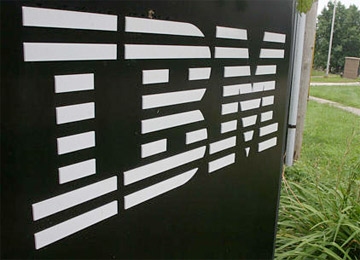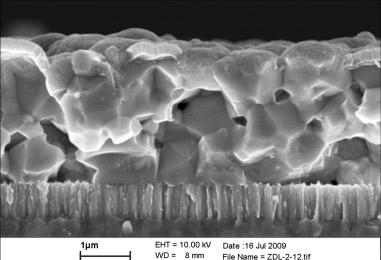 The Secret Ingredients Inside IBM’s New Solar CellFeb 19, 2010 - Michael Kanellos - greentechmedia.com Think thin films for thin film.Selenization. In the solar business, it's a code word for 'headache.' One of The techniques for applying selenide vary: some create copper, indium and gallium selenides and then apply these substances to substrates, while others introduce selenide with a jet of hydrogen gas in a high temperature chamber. "It becomes a complicated process to control all of these elements," said David Mitzi, who leads a team at IBM Research that last week unveiled an unusual solar cell made from copper, tin, zinc, selenium and sulfur (CTZSS). "Cadmium telluride (the basis for First Solar's solar cells) is pretty simple. You can evaporate bulk cad tel and get it to land as bulk cad tel."
IBM devised a somewhat novel approach to the selenide problem and other manufacturing issues that could help push CTZSS solar cells from the fringes of the PV world to mainstream production over the next several years. It won't be easy, but at least the door is open. The technique involves embedding selenide and sulfur into a film, according to Mitzi. First, structures made of copper and tin and zinc and tin are dissolved into a solution. This solution then gets sprayed onto the selenide-sulfur film in a process that's akin to inkjet printing. Heat is applied next, which causes the metals to bond to the sulfur and selenide. The fact that the two elements become embedded into a patterned film serves to create a structure for the solar cell. The heat also causes the liquid (a hydrozene) that carried the metals to decompose completely. "There are no impurities remaining," he said. While heat is required, the process demands less heat than the vacuum processes associated with chip making and some types of solar-cell production. Thus, mass manufacturing of these cells conceivably could undercut conventional processes in terms of cost. Mintz also reminded me of another crucial difference between silicon and other thin films. Silicon solar cells are indirect band gap semiconductors, while the C-class solar cells (apologies to Mercedes) are direct band gap semiconductors. That means CIGS, CIS, CIS II (copper indium sulfide) or CTZSS solar cells can use fewer raw materials and can be thinner or more easily inserted onto flexible substrates. For years, scientists have tinkered with CTZSS solar cells, but the industry has largely focused on CIGS as a result of better and steadier progress in the lab. Most experimental CTZSS solar cells have hovered around the 1 to 2 percent efficiency level until just recently. A team of Japanese researchers managed to produce a prototype cell with a 6.7 efficiency; in contrast, IBM's new cell can convert 9.6 percent of the energy that strikes it into electricity. Still, that's far below CIGS levels. The National Renewable Energy Labs have hit nearly 20 percent efficiency with experimental CIGS cells, while companies like Nanosolar have started to commercially produce CIGS cells in the 12 percent range and has some in the lab that are hitting 16.4 percent efficiencies. Still, it's a start, and if CTZSS solar cells can be scaled up for mass manufacturing, it could reduce some of the commercial risks surrounding C-class cells. CTZSS cells should behave like CIGS cells and thus achieve the high efficiencies that have attracted venture capitalists to CIGS. CTZSS cells, however, don't have indium. Indium is a rare and typically expensive element that's also consumed by manufacturers of large screen TVs. Zinc and tin are common, so swapping out the indium potentially could make these solar cells cheaper. At a minimum, they shouldn't be more expensive. More importantly, zinc and tin will alleviate fears about shortages. "Indium is often indicated as a problem for CIGS on a terawatt scale," he said. The next step for IBM will lie in trying to produce cells that can achieve 12 percent efficiency. That would make it possible to develop solar modules with 10 percent efficiency. IBM will also probe for potential defects. As work progresses, IBM will seek partners to commercialize the cells. While IBM has become a major figure in batteries, water technology and solar in the past few years, Big Blue will largely license the ideas from its labs and rely on partners to commercialize them. |
Updated: 2003/07/28
 the major hurdles facing manufacturers of
the major hurdles facing manufacturers of 